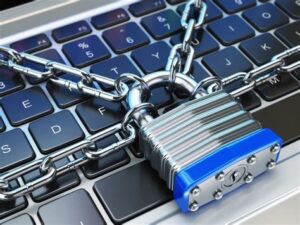In a world where the majority of our financial, professional, and personal transactions are conducted online, taking steps to secure your digital life is no longer optional. Cybercrime continues to increase each year. Consider these statistics:
- At least 330 million people were victims of some type of cybercrime in 2020

- There were 1.51 billion IoT [Internet of Things] device breaches in the first half of 2021
- Google predicts that 20% of social accounts will be compromised sooner or later
If you are a little behind in taking steps to secure your digital life, you can get started with this 3-pronged approach: 1) lock down accounts, 2) monitor transactions & activity, and 3) minimize exposure.
Lock Down Accounts
The most obvious way to lock down your digital life is to make sure that all of your passwords are long, complex, and unique. Do not share passwords with others, write them on a post-it note, or reuse them. We highly recommend using a password manager such as Dashlane, RoboForm, or LastPass (or another reputable one). The small annual fee you’ll pay is well worth the functionality and security that these applications provide. The process of resetting all of your passwords is time-consuming, but the long-term benefit is well worth it.
Secondly, lock down your accounts by setting up two-factor (2FA) or multi-factor authentication (MFA). This is an added layer of security that requires you to receive a code via text or email each time you log in. Your email account is the most important account to secure with multi-factor authentication. If hackers are able to breach your email account, they may be able to change your passwords by sending “reset password” links to the email address that they now have access to.
Monitor Transactions & Activity
Several measures can be taken to monitor your accounts. The easiest way is to set up alerts and notifications. An example of this is receiving a text or email notification when a charge is made on your credit card. Secondly, establish an account with the 3 major credit bureaus (Experian, TransUnion, Equifax) to monitor your credit. You can also freeze your credit with each bureau which prevents someone from opening a loan, credit card, or line of credit using your social security number. Lastly, several companies such as a LifeLock, IDShield, and Zander offer account and credit monitoring for a fee. While these services are somewhat pricey, the cost of the service is minimal relative to the risk of a large financial loss.
Minimize Exposure
One of the easiest ways to minimize exposure is to reduce the amount of mail coming to your mailbox. The only way to prevent someone from stealing your bank or brokerage statements from your mailbox is to turn off paper delivery. This reduces exposure of your financial information to bad actors. and it also saves paper – a win for the environment!
Finally, minimize your exposure by making sure that your home network is secure and your anti-virus software is up to date. Most homes now have numerous “smart” devices such as thermostats, coffee makers, and light switches. Known as IoT devices, they are often the least secure point of most home networks. A network professional can ensure that your home is secure by segregating your IoT devices from your secure data.
Conclusion
Being the victim of cybercrime is extremely stressful, time-consuming, and costly. We all have to be vigilant to secure our online data and protect our assets.